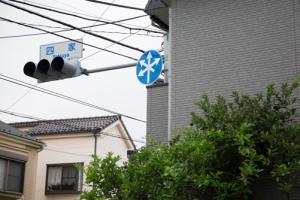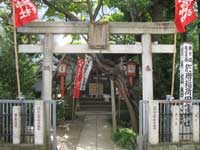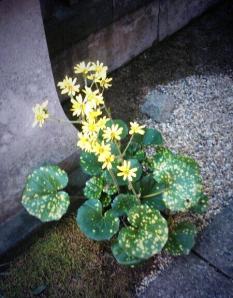“Yotsuya Zotanshu” and “Yotsuya Kaidan”are two linked promenade works by Shigeki Nakano and Kaku Nagashima which were part of the Festival/Tokyo program in 2013. These two works gave us the opportunity to reconsider what is the essence of a story that keeps being retold over the centuries. They dealt with a story from Edo period Japan (1603-1868), known under the name of “Yotsuya Kaidan”, transposing it into the urban space of nowadays. The effect of this transposition was surprising, showing that the original story itself is very “plastic”, easily adaptable to conditions very different from the ones in which it first emerged.
Going back in history, “Yotsuya Zotanshu” is originally the name of a collection of urban legends from the beginning of the eighteenth century in the city of Edo (the historical name for Tokyo), and one of the most famous tales among them is the story of a tragic woman: Tamiya Oiwa. Betrayed by her husband Iyemon and chased away from home, she disappears, but from that day on until 30 years afterwards, everybody related to her, especially Iyemon’s new family, encounters an unnatural death. Based on these urban myth and 100 years afterwards, the Kabuki play “Tokaido Yotsuya Kaidan” was created. However, the playwright Tsuruya Nanboku took the liberty of changing the plot radically in order to bolster the drama and to intensify the visual effects of the stage performance. Thus in the Kabuki version, Oiwa gets poisoned by her rival, becomes disfigured and her dead body is thrown in a river, nailed down to a wooden board. Moreover, her ghost repeatedly appears to haunt Iyemon until his death.
Oiwa’s story is undoubtedly the most popular kwaidan (怪談 “horror story”), as everyone in Japan knows it and feels sympathetic to the heroine. Thanks to the visual culture associated with the story – combining visual art, stage and film remakes – Oiwa remains very vivid in the collective imagination of the Japanese.
However, now nearly 200 years after the premiere of the Kabuki version, Shigeki Nakano and Kaku Nagashima have recreated both “Yotsuya Zotanshu” and “Yotsuya Kaidan” into contemporary fictions in which the story was presented in the form of promenade performances in two areas in Tokyo – Yotsuya (四ツ谷) in Chiyoda ward and Yotsuya (四家) in Adachi ward.
Before taking part in “Yotsuya Zotanshu”, the members of the audience were handed a booklet with photographs of the Yotsuya area of today, against which we could read a brief summary of Oiwa’s story. The starting point was either Shufu-kaikan Plaza F (“Ladies’ Hall Plaza F”) or Square Kojimachi Hotel, which is renowned as a place for wedding ceremonies. (Can it be just a coincidence that these places are associated with women?) After a brief introduction, we departed for a guided tour through the Yotsuya and Shinjuku areas. The first stop was on the bridge over Sotobori channel (the outer moat to the Imperial Palace), which is said to be the same as it was in the Edo period. Walking along the tiny backstreets, we encountered small temples where time seems to have stopped. They were all related to “Yotsuya Kaidan” or to the age when Oiwa and her spouse Iyemon are supposed to have lived. The tour ended at a small altar that was built a long time ago in the memory of Oiwa – or, to be exact, in order to appease her vengeful soul.
“Yotsuya Kaidan”, on the other hand, was a new version of Oiwa’s story, wittily written by Shigeki Nakano himself. In this updated narrative, Oiwa is a university student, dreaming of becoming an “idol”. She meets Iyemon at the bar where they are both employed as part-time workers and they fall in love. However, to Oiwa’s disgrace, Iyemon is already married. Upset, she leaves him off and disappears around the Yotsuya crossing of Gotanno area. All the signs show that she is headed for a new beginning in her life, with the motto: “Hope is all that we have.”For this tour the members of the audience were given maps with the places related to the new Oiwa and her story, such as the bar where the two meet, the riverside where they talk about breaking up, or the restaurant where they have their last date. This time the spectators travel alone, free to choose their pace and to enjoy the atmosphere of the area.
Just like in the case of Nagashima’s “Yotsuya Zotanshu”, you cannot help but realize that if this were not a tour performance, you would never have visited and strolled around so freely in the area. The concept of these works creates the framework for us to see the city with new eyes, through the filter of this story.
By letting the city speak – or better said, by giving us the opportunity to listen to the city’s voice– these promenade works are determined to make us realize that Oiwa’s story is there, among thousands of other stories, old and new. The place names that haven’t changed since the Edo period, the plants, the rivers that cross the city, the old temples that have been named after the characters of “Yotsuya Kaidan” – they all serve as reminders, pieces of memories that should help us reconstruct the story. Of course, the creators themselves, as well as the audience – who is the actual performing agent in these promenade works – are well aware that the story will never be the same as the original one. In the minds of the audience emerges a new version of “Yotsuya Kaidan” –one which borrows the structure of the old popular horror story, but is transposed into the Tokyo of our times, personalized by the experience and the perspective of the spectators from the twenty-first century. For example, the fact that Shigeki Nakano’s Oiwa is a student, working part-time just like many people of the same age, contributes a great deal in breaking her ghastly, otherworldly image and bringing her closer to us.
This reminds us that the true essence of any story which endures over the centuries is its mutability, its adaptability to the conditions of each new generation. If stories do not change, if they do not receive new elements with each retelling, and far from being “protected”, in fact they might very soon end up forgotten. Therefore, we might say that what ensures the long-lasting popularity of a story is its openness to change.
These two linked promenade works powerfully suggest that it’s not enough just to feel pity toward Oiwa. Her story is in our hands and we can choose the ending that we want for it. This also goes for other stories, including the epic stories which are our lives in this society – marked from time to time by irreversible tragic events. “Yotsuya Zotanshu” and “Yotsuya Kaidan” are about the courage to rewrite a story whose ending was originally sad and full of resentment: the ambition of turning that ending into a hopeful one. Unlike her Edo-period counterpart, the Oiwa of the twenty-first century has the strength to look into the future, with no resentment toward the ones who did her wrong. In Shigeki Nakano’s words, the dreaded Iwa (岩) has become “celebration” (iwai 祝).
(* This article has first appeared on the “Blog Camp in F/T” platform, a Festival/Tokyo 2013 program for young critics lead by performing arts journalist Iwaki Kyoko, and was reblogged with permission.)



